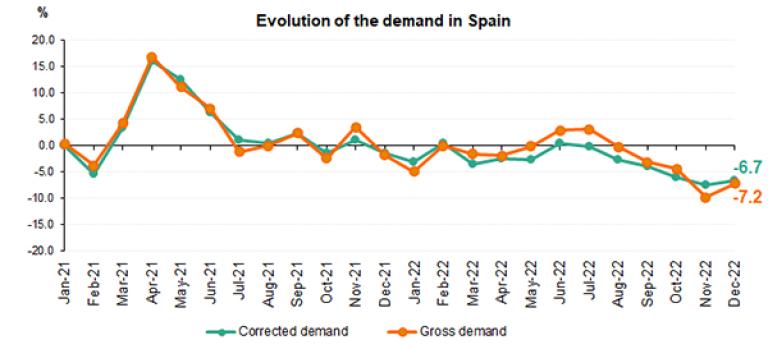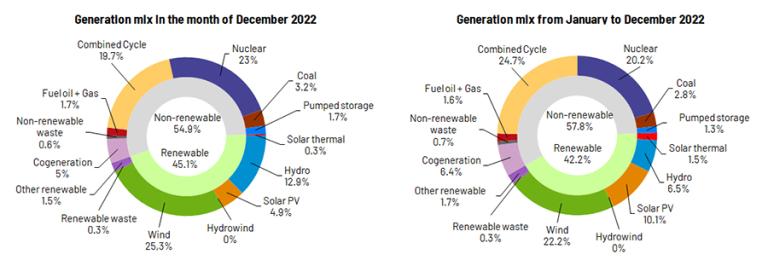- 45.1% of Spain’s electricity generation in December was obtained from renewable sources and 69.3% came from zero-carbon energy technologies
- Annual wind and solar photovoltaic energy production exceeded the figures registered in 2021, setting all-time highs for both technologies
- Electricity demand in the Balearic Islands fell by 3% and increased by 1.5% in the Canary Islands compared to December 2021
After having factored in the influence of seasonal and working patterns, national electricity demand decreased by 6.7% in December compared to the same month last year. In gross terms, demand is estimated at 20,437 GWh, down 7.2% compared to December 2021.
For the year as a whole, demand is estimated at 250,596 GWh, a value that is 2.3% less than that recorded in 2021. After having factored in the influence of seasonal and working patterns, annual demand is 3.2% lower than in 2021.
According to data estimated at the time of this press release, production from renewable energy sources in December accounted for 45.1% of the national generation mix. During December, green energy production stood at 10,120 GWh, down 8.8% on that recorded in the same period in 2021. On the other hand, 69.3% of electricity production during the month was obtained using zero-carbon energy technologies.
According to information available at the time of this press release, wind power was the leading technology in Spain’s generation mix during December. Specifically, its production accounted for 25.3% of the total generation mix (5,661 GWh). For its part, solar photovoltaic, with 1,098 GWh registered in December, increased its production by 7.3% year-on-year, reaching a share of 4.9% of the total generation mix.
The cumulative annual production from wind (61,255 GWh) exceeded that of the whole of 2021 by 1.2%, thus establishing a new all-time high for this renewable energy, while annual solar photovoltaic production, with 27,830 GWh, exceeded that of the whole of the previous year by 32.6%, also setting an all-time high.
Hydroelectric power generation in December increased by 13.8% year-on-year with a total of 2,887 GWh; but closed 2022 with its lowest electricity production in the last three decades due to low rainfall.
In the whole of 2022, renewable energy production accounted for 42.2% of the generation mix nationwide, with wind power as the second source of generation (22.2% of the total) and solar photovoltaic as the fourth (10.1%).
Demand for electricity in the peninsular system
After having factored in the influence of seasonal and working patterns, demand for electrical energy on the peninsula was 7.0% lower than in December 2021 (19,275 GWh, a figure that is 7.5% less in gross terms than that recorded in the same month of 2021).
From January to December 2022, electricity demand on the Spanish mainland is estimated at 235,620 GWh, down 2.9% compared to the same period in 2021. In this case, after having factored in the influence of seasonal and working patterns, annual demand is down 3.8% year-on-year.
During December, and according to data estimated at the time of this press release, 47.0% of electricity generation on the mainland came from renewable sources and 72.5% was obtained using zero-carbon energy technologies.
Furthermore, wind power totalled 5,622 GWh, accounting for 26.4% of the total generation mix, making wind the leading source of generation on the Spanish mainland in December. Meanwhile, solar photovoltaic, with 5.0% of the generation mix, increased its production by 6.8% to 1,063 GWh.
Demand for electricity in the Balearic Islands and the Canary Islands
Electricity demand in the Balearic Islands during December fell by 3% after having factored in the influence of seasonal and working patterns. In gross terms, monthly demand is estimated at 399,403 MWh, down 8.3% on the figure recorded in December 2021.
In terms of generation, combined cycle, with a 79.3% share of the energy produced in the Balearic Islands, was the leading technology on the islands in December. Renewable energy obtained using zero-carbon energy technologies in the Balearic Islands generated 8.2% of the total. In addition, during this month, the submarine link between the mainland and Majorca contributed to covering 19.9% of the electricity demand in the Balearic Islands.
For the year as a whole, Balearic Islands’ demand is estimated at 6,040,630 MWh, up 9.3% on that registered for 2021; a value that is up 9.7% after having factored in the influence of seasonal and working patterns.
Meanwhile, in the Canary Islands, the demand for electricity, after having factored in the influence of seasonal and working patterns, increased by 1.5% compared to the same month the previous year. Thus, in gross terms, demand stood at 731,069 MWh, up 1.6% year-on-year.
With regard to electricity generation in the Canary Islands, combined cycle, with 48.4% of the total generation, was also the leading technology in December, while renewables and zero-carbon energy technologies accounted for 8% of production, with wind power representing 5.3% of the total mix on the islands.
For the year as a whole, demand in the Canary Islands is estimated at 8,543,265 MWh, up 5.9% on that registered for 2021; a value that stands at 5.6% after having factored in the influence of seasonal and working patterns.
Consult our Daily Balance Report for more information on the National, Peninsular, Balearic Islands and Canary Islands electricity systems as at the close of December.

